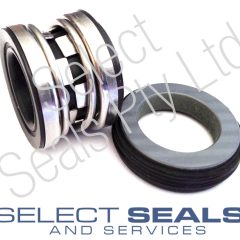Mechanical Seals For Centrifugal Pumps
Centrifugal pumps use the rotational energy and mechanical seals to move fluids through a pipe system. Rotational energy is usually supplied by an engine and it is converted into hydrodynamic energy, thus making the fluid flow.
The pump has a mechanical seal located nearby the rotating axis. Once the fluid gets in, it is directed by the propeller towards the diffuser, where it finds its way out.
Centrifugal pumps are mostly used for pumping water, petroleum and derivatives or sewage fluids. When used in reverse, centrifugal pumps function like water turbines, converting potential energy into mechanical energy.
The history of centrifugal pumps
Apparently, the principle of centrifugal pumps was first used in 1475, in a machine which had the purpose of lifting mud. This machine was first mentioned by Francesco di Giorgio Martini, an Italian engineer that lived in the Renaissance age. The first real centrifugal pump was actually built in the second half of the 17th century by Denis Papin. Papin’s pump used only straight vanes. Curved ones were invented much later, in 1851, by John Appold, a British inventor.
Basically, centrifugal pumps with mechanical seals have the same function as any other type of pump: it converts mechanical energy into kinetic energy, or the motion energy of a fluid. Only a part of the mechanical energy gets converted into kinetic energy, though, the rest being transformed into potential energy represented either by fluid pressure or by lifting the fluid at a higher level, thus fighting gravity.
Long time ago, the modern concept of the centrifugal force as a fictitious force was unknown, therefore older sources refer to the centrifugal force as being the energy transfer from the impeller rotation to the pressure and motion of the fluid.
The pressure under which the fluid comes out of the pump is directly related to the pressure applying the centripetal force that makes the fluid move inside the pump.
Nonetheless, if we interpret the following statement, “outward force generated within the wheel is to be understood as being produced entirely by the medium of centrifugal force”, through the prism of a fictitious force that is the centrifugal force in the reference frame of the rotating impeller, it starts to make perfect sense. The forces that effectively act upon the water and make it move in circles are inward.
This force is produced by a pressure difference established in place by the rotation itself, while the pressure at the exterior can be interpreted as a reactive centrifugal force.
Mechanical Seals in vertical centrifugal pumps
Also known as cantilever pumps, vertical centrifugal pumps feature a unique shaft and bearing support combination that results in the volute hanging in the sump. At the same time, bearings are outside of the sump. There’s no stuffing box that seals the shaft, but another configuration, known as a “throttle Bushing”.
Vertical centrifugal pumps are used in applications like parts washers.
Froth pumps
Froth is widely used in the mineral and oil extraction industry. It has the role of separating the minerals or the bitumen from clay and sand. Because froth contained a lot of air, it tends to block conventional pumps.
Back in the old times, the solution to this problem was to use a vertical pump with a tank. Another solution was to build a special pump that had a special impeller which could break the air bubbles. For instance, in the pulp and paper industry, such pumps with holes in the impeller are used.
As the air runs through the back of the impeller, a special expeller takes it from there and directs it back into the tank. Some impellers may also have additional vanes, smaller than the main ones, vanes known as split vanes or secondary ones.
Other pumps may feature other systems for breaking the bubbles, like a large eye or an inducer of pressurized froth back to the suction tank.
Mechanical seals in multistage centrifugal pumps
If a centrifugal pump has more than one impeller, it is known as a multistage centrifugal pump. The impellers can be situated on the sane shaft or on different ones. When impellers are connected in series, the result is a higher pressure at the outlet. If a higher flow output is desired, the impellers need to be connected in parallel.
The operating principle
The impeller is coupled to the motor via a magnetic connection, across a fluid-resistant separation wall. The motor moves a rotor that bears one or more pairs of permanent magnets. At their turn, these magnets drag around other pairs of magnets that are connected to the impeller.
Priming
As most centrifugal pumps are not self-priming, they need to be filled with fluid before they can start, or they won’t be able to operate. If the casing of the pump gets filled with gas or vapors, the impeller will be unable of doing its job.
In order to prevent gas and vapor accumulation in the casing, centrifugal pumps are usually located at a lower level than the source it is supposed to suck from. This positioning will prevent the casing from becoming empty, thus making it impossible for vapors or gases to get inside.
Another way of preventing gas from entering the casing is to supply the fluid under pressure, this pressure being generated by another pump that’s situated in the same suction line.


